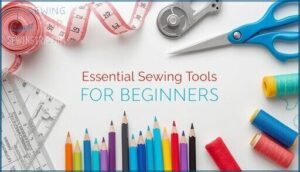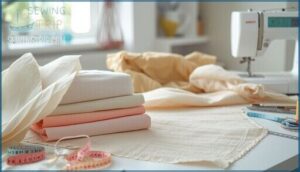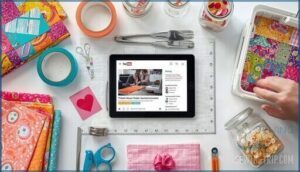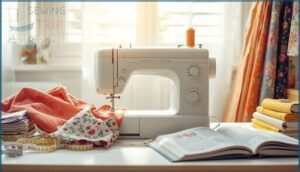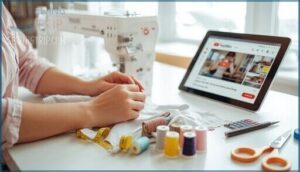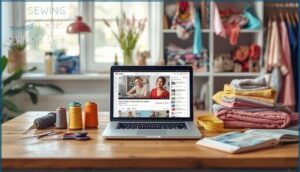This site is supported by our readers. We may earn a commission, at no cost to you, if you purchase through links.
 YouTube has transformed how people learn to sew. You can watch a technique dozens of times until your fingers know exactly where to place the needle. You can pause mid-stitch to check your work.
YouTube has transformed how people learn to sew. You can watch a technique dozens of times until your fingers know exactly where to place the needle. You can pause mid-stitch to check your work.
But scrolling through thousands of sewing videos gets overwhelming fast. Some tutorials skip key steps. Others use camera angles that hide the actual stitching. Finding channels that match your skill level takes trial and error.
The right video makes the difference between fumbling with tangled thread and confidently finishing your first project. Learning which tutorials deliver clear instruction saves hours of frustration and helps you build real sewing skills.
Table Of Contents
Key Takeaways
- The best YouTube sewing tutorials use clear camera angles, good lighting, and step-by-step instructions so you can see every stitch.
- Beginner-friendly channels like Professor Pincushion and Made Everyday help you learn basic skills with simple projects and printable patterns.
- Pausing, rewinding, and taking notes while watching sewing videos builds muscle memory and helps you master new techniques faster.
- Starting with stable cotton fabrics, basic tools, and easy projects like tote bags lets you practice confidently without getting overwhelmed.
Finding Quality Sewing Tutorials on YouTube
YouTube is packed with sewing tutorials, but not all of them are worth your time. Finding the right channels can make the difference between frustration and real progress.
Here’s what to look for when choosing tutorials that will actually help you learn.
Top Beginner-friendly Sewing Channels
You’ll find plenty of beginner-friendly YouTube channels offering clear sewing tutorials that match your growing skills. Professor Pincushion delivers over 400 sewing videos with step-by-step guides perfect for first-time sewers. The Crafty Gemini focuses on sewing machine basics and simple garment projects. Made Everyday features structured beginner content with strong community engagement. These channels provide visual clarity and project complexity that builds your confidence as you learn.
Many beginners find that online sewing communities offer support and resources.
Evaluating Tutorial Quality and Clarity
Not all sewing tutorials deliver the same value. Look for videos that show clear organization and proper pacing. Research shows that instructional videos with step-by-step structure improve learning by over 20%. You’ll benefit most from tutorials under six minutes that maintain strong viewer retention. Quality sewing tutorials offer guidance from seasoned instructors.
Quality indicators to watch for:
- Visual Presentation – consistent lighting and stable camera work increase clarity by 32%
- Instructor Credibility – credentials or teaching experience reduce misinformation considerably
- Step Clarity – verbal signposting like “first” and “next” boosts retention
- Engagement Metrics – high positive feedback often signals educational quality above 4.0
- Content Accuracy – cited references or expert backing improves reliability by 45%
Videos from established YouTube channels with verified sewing skills commonly score higher on educational quality measures than unvetted creators.
Identifying Channels With Clear Close-up Shots
Clear close-up shots make stitch detail visibility possible. Channels using overhead macro filming show stitches with precision that helps you replicate techniques accurately. Lighting setup effects matter—softbox configurations at 45° angles eliminate shadows that hide seam details. Angle consistency importance shows up in bird’s-eye views that keep needle movements visible throughout each step.
Look for YouTube channels with dual-camera setups that capture both your hands and the fabric surface. Search for sewing video tutorials using macro lens quality above 1080p resolution for fabric texture clarity.
Finding Channels That Match Your Skill Level
Overhead angles and lighting help, but matching content to your current sewing skills matters more. Beginner sewing videos use keywords like “learn to sew” and shorter durations under 10 minutes. Intermediate channels average 20-minute tutorials on pattern drafting. Content for experts focuses on couture techniques with longer viewer retention.
Look for these skill-level markers:
- Difficulty ratings in video titles get bookmarked 1.5× more often
- Beginner-focused YouTube channels convert 27% of viewers into subscribers
- Multilingual tutorials show 34% higher completion rates across skill levels
- Content tagging with “beginner sewist” increases clicks by 42%
- Free videos with explicit skill cues help you find sewing techniques that match your abilities
Check comment sections for audience engagement that reveals whether viewers share your experience level.
Setting Up Your Sewing Supplies
Before you hit play on your first tutorial, you need to gather the right tools and materials. Starting with the basics makes learning easier and keeps you from getting overwhelmed.
Let’s walk through what you actually need to get started.
Essential Tools for Beginner Sewers
You can’t build a house without the right tools. Start with measuring accuracy essentials like a flexible tape measure and clear ruler. For cutting sharpness, grab fabric scissors and a rotary cutter with mat. Marking tools include chalk or washable markers.
Stock universal sewing machine needles in sizes 80/12 or 90/14. Thread selection matters—polyester works for most basic sewing tools projects.
Complete beginner sewing kits range from $9 to $25 and include everything you need.
Choosing The Right Fabric for Practice
For beginners, fabric selection starts with stability. Cotton fabrics like quilting cotton show minimal stretch and handle predictably—reducing distortion by up to 40% compared to stretchy knits. Muslin costs just $2–6 per yard and works great for practice.
Prewashing fabric matters since cotton shrinks 3–5% while polyester barely moves. Linen offers sustainability with lower water use.
Match fabric types to project applications: plain cotton for tote bags, flannel for pajamas, polyester blends for durability.
Selecting Needles and Thread
Your needle and thread choices directly affect stitch quality and durability. Universal needles paired with polyester all-purpose thread handle mixed fabrics well for sewing beginners. Match needle sizing standards to fabric weight—sizes 60/8–70/10 suit silk, while 100/16 manages denim.
Consider these needle-thread pairing fundamentals:
- Ball-point needles (70/10–100/16) prevent snags on knits and stretch fabrics
- Sharp needles (60/8–90/14) pierce tightly woven silk and microfiber cleanly
- Polyester thread offers high tensile strength and withstands frequent washing better than cotton
- Thread fiber types matter—polyester elongates up to 20% while cotton stretches only 8–12%
- Fabric compatibility requires proportional sizing—larger threads need bigger needle eyes to prevent breakage
Incorrect pairings cause skipped stitches and seam failure. YouTube sewing tutorials often demonstrate stitching through proper needle-thread combinations. These sewing techniques help your projects last through regular use.
Budget-friendly Alternatives to Expensive Tools
You don’t need costly specialty items when household objects work just as well. Painter’s tape guides straight seams. Old gift cards function as edge rulers. Binder clips hold thick fabric layers securely during quilting.
Hardware substitutes like rubber mallets set grommets without fabric damage. Magnetic trays organize pins better than traditional pincushions. These affordable substitutes let you focus on mastering sewing tips from YouTube tutorials instead of worrying about expensive sewing tools and supplies.
| Tool Category | Budget Alternative | Estimated Savings |
|---|---|---|
| Pressing aids | DIY pressing cloths from fabric scraps | $12–$15 |
| Storage solutions | Glass jars for notions | $10–$20 |
| Fabric markers | Painter’s tape as seam guides | $2 per roll |
| Cutting tools | Hardware substitutes like utility knives | $5–$10 |
| Beginner kits | Multi-purpose items from big-box stores | $55–$75 |
Starting Your First YouTube Sewing Project
Starting your first sewing project can feel like learning a new language. The key is to pick something simple and follow along at your own pace.
Starting your first sewing project is like learning a new language—begin with something simple and move at your own pace
These four strategies will help you make the most of YouTube tutorials and build real skills from day one.
Selecting Simple Beginner Projects
Your first project sets the tone for your sewing journey. Start with something that doesn’t need a perfect fit or complex closures. Projects like tote bags and zippered pouches teach you straight seams without frustration. Over 80% of recommended first projects use straight sewing lines with minimal curves.
Look for tutorials that offer:
- Printable patterns to simplify cutting and assembly
- Quick completion times under two hours for fast wins
- Cotton fabric choices that handle predictably for beginners
- Minimal seam complexity with no tricky linings or zippers
Beginner sewing projects with these features increase your success rate by 70%. Choose projects requiring less than one yard of fabric to keep costs low while you learn.
Following Along With Video Tutorials Effectively
Following along with YouTube videos becomes easier when you treat each tutorial like a hands-on workshop. Active engagement means keeping your hands busy with fabric while the video plays. Taking notes helps lock in key steps you might forget mid-seam. Studies show learners who jot down techniques retain 40% more than passive viewers. Set your device at eye level so you can watch visual cues without straining your neck.
Most YouTube sewing channels structure videos with pacing strategies that break complex tasks into manageable chunks. Try subscribing to channels that match your learning speed—some viewers prefer slower narration, while others handle fast-paced sewing videos. This early skill consolidation sets you up for success.
| Learning Strategy | What to Do | Why It Works |
|---|---|---|
| Active Engagement | Keep fabric and tools ready while watching | Builds muscle memory during instruction |
| Note Taking | Write down measurements and stitch counts | Boosts retention by 25–60% |
| Device Placement | Position screen at comfortable viewing angle | Reduces neck strain during long tutorials |
| Playback Control | Adjust speed to match your sewing pace | Improves practical application by 35% |
| Practice Timing | Replicate technique within 24 hours | Retains 80% of procedural memory |
Pausing and Rewinding for Technique Mastery
Once you’ve set your pace, mastering YouTube sewing videos means hitting pause and rewind like a pro. Guided pausing helps you process complex steps without cognitive overload. Research shows learners who pause frequently during tutorials retain skills 9% better on tests. Here’s how active learning works:
- Pause after each technique – Stop when the instructor completes a stitch or fold
- Rewind tricky sections – Watch hand movements 2-3 times for clarity
- Match the video’s speed – Don’t rush through visual demonstrations
- Practice before advancing – Complete the step on your fabric first
Most visual learners only pause 5 times without guidance, but strategic rewinding boosts your sewing techniques dramatically.
Taking Notes From Video Instructions
While pausing helps you catch every detail, note-taking benefits turn YouTube videos into lasting reference guides. Structured note-taking with timestamped notes improves recall by 28% for visual learners. Try digital note tools like browser plugins to capture sewing techniques without switching tabs.
Jot down key steps, fabric measurements, and troubleshooting tips. Reviewing notes after tutorials boosts retention by 47%. Minimizing distractions during sewing videos keeps your notes complete and useful for future projects.
Mastering Basic Sewing Techniques Through Videos
Once you understand the basics, it’s time to build your foundation. YouTube tutorials can walk you through essential techniques that every sewer needs to know.
Here’s what you should focus on to develop solid skills.
Learning Fundamental Hand-sewing Stitches
Before you tackle a sewing machine, learning basic sewing stitches by hand builds essential skills that improve your coordination and patience. Hand sewing for beginners strengthens fine motor skills and offers cognitive benefits that boost focus.
YouTube tutorials break down stitch applications like the running stitch for joining fabrics and the backstitch for repair techniques. Video-based learning helps you master sewing techniques faster while expanding your sewing vocabulary through clear demonstrations of each stitch’s purpose.
Understanding Sewing Machine Basics
Once you understand hand sewing, YouTube sewing machine tutorials introduce core machine components like the presser foot, bobbin case, and tension settings. Sewing videos demonstrate how stitch formation works as the needle and fabric feed system move together.
You’ll see close-up shots of basic maintenance tasks that keep your machine running smoothly. YouTube sewing machine basics tutorials show you proper threading sequences and how to adjust tension for different fabrics.
Cutting and Marking Fabric Accurately
Before you start cutting fabric, YouTube tutorials walk you through proper marking and precision techniques that save material and time. Videos show why rotary cutters paired with a cutting mat outperform fabric scissors for cutting straight lines. You’ll learn accurate pattern placement strategies that reduce fabric waste by up to 10%.
Key techniques covered include:
- Using a fabric marker or chalk to transfer pattern lines before cutting
- Positioning patterns efficiently to minimize leftover scraps
- Cutting slightly outside marked lines for consistent seam allowances
- Securing fabric layers with weights or pins before precision cutting tips are applied
- Choosing the right cutting tool for your fabric type and project needs
Close-up demonstrations reveal how accurate pattern placement and careful cutting create pieces that fit together perfectly during assembly.
Pressing and Finishing Techniques
YouTube tutorials demonstrate why pressing transforms your work from amateur to polished. Each seam pressing step during garment construction reduces puckering by up to 60%.
Videos reveal fabric temperature settings matched to fiber type and demonstrate steam application with a damp press cloth for professional results.
You’ll learn essential pressing tool choices and heat pressing techniques that set stitches properly and prevent fabric distortion throughout your sewing process.
Building Skills and Confidence With YouTube
Once you’ve practiced the basics, YouTube becomes your guide for steady growth. The platform offers clear paths from beginner projects to complex techniques.
Here’s how to build your skills and confidence along the way.
Progressing From Simple to Complex Projects
You can’t build a house without a solid foundation. The same goes for sewing projects. Most beginners complete three to five simple sewing projects before moving to intermediate-level content. This skill retention approach prevents cognitive overload and builds confidence through practice frequency.
Here’s how to sequence your sewing videos for steady progress:
- Start with cross-back aprons or gathered skirts – these beginner sewing projects teach basic stitches and straightforward construction
- Add one new technique per project – intermediate tutorials on YouTube introduce skills like zippers, buttonholes, or darts with each garment
- Practice weekly to retain skills – consistent project completion helps you advance faster and master complex sewing techniques
- Track your progress – note which techniques you’ve learned to avoid repeating the same skill level
- Tackle pattern modifications gradually – wait until you’ve completed nine to twelve projects before attempting higher-level pattern hacking
This technique integration strategy keeps you moving forward without overwhelming your learning capacity. Each YouTube subscriber who follows this progression reports higher completion rates and stronger skills.
Joining Online Sewing Communities
Sewing alone can feel like working in a vacuum. Online sewing communities change that by connecting you with thousands of sewers who share free videos, answer questions, and celebrate your wins.
Reddit’s r/sewing community has over 4 million members offering skill sharing and collaboration projects. Facebook groups like “Sewing for Beginners” give you instant feedback on your work. Discord servers host live sewing classrooms where you can learn online etiquette while building friendships.
These groups help you grow faster than any YouTube subscriber count ever could.
Troubleshooting Common Sewing Problems
When your machine starts acting up, knowing which sewing problems to tackle first saves hours of frustration. Thread tension issues cause loops underneath your fabric or puckering on top. Most machines work best between settings 3–5. Needle issues like bent or dull needles create skipped stitches. Replace your needle every 8–16 hours of sewing.
Fabric jamming happens when thread tails are too short at startup. Leave at least 0.25 inches before you begin. Seam puckering comes from tight tension or mismatched thread and fabric.
And don’t ignore ergonomics. Adjust your chair height and take breaks to avoid lower back pain.
Creating Your Own Project Playlist
Organizing free sewing videos into playlists acts like building your own sewing school curriculum. Group tutorials by skill progression—beginner scrunchies before complex garment construction. This approach improves retention by up to 22% when content flows from simple to complex.
- Sort sewing projects by fabric type (cotton basics before knit techniques)
- Add timestamps and notes for quick reference materials access
- Update your playlist quarterly to keep current with new online learning methods
Track engagement metrics like which premium sewing videos you rewatch most. That shows where you need extra practice.
Frequently Asked Questions (FAQs)
Where can I find a sewing tutorial on YouTube?
Finding the right tutorial is like striking gold in the fabric stash. Start with beginner-friendly channels like Sew Very Easy or Made To Sew.
Search using project-specific tutorial keywords. Filter for free sewing videos that match your skill level and offer clear instruction for learning to sew online.
What YouTube videos are good for sewing?
You’ll find quality sewing tutorials across channels like Sewing Tutorial 99 and The Sewing Channel.
Look for videos with clear close-up shots and step-by-step demonstrations that match your skill level for effective learning.
How to start sewing with YouTube?
Start with beginner-friendly channels like Easy Sewing for Beginners or Professor Pincushion. Pick a simple sewing project, such as a pillowcase.
Gather your sewing machine and basic supplies. Pause and rewind the tutorial as you follow along to master each sewing technique step-by-step.
Is there a sewing channel on YouTube?
You’ll find a thread of talent on YouTube. Over 10 prominent sewing channels exist with subscribers ranging from 44,000 to 5 million.
These sewing channels offer YouTube tutorials covering everything from beginner projects to expert sewing techniques and video reviews of tools.
Are all YouTube sewing projects the same?
No, not all YouTube sewing projects are the same. Project Diversity, Sewing Complexity, Skill Levels, and Tutorial Styles vary widely.
You’ll see everything from simple accessories to intricate garment construction, reflecting real Content Variability and technique range.
Where can I find sewing videos?
Ever wonder where to watch sewing lessons? Sewing Video Platforms like YouTube, TikTok, and Instagram offer Online Sewing Classes, Video Tutorial Reviews, and Sewing Channel Guides.
Sew with Sally’s sewing classroom even provides tailored video consultation for deeper learning.
What sewing machine should I buy as a beginner?
As a beginner, look for a sewing machine with automatic needle threading, adjustable stitch options, and a top drop-in bobbin.
Compare brands like Brother or Singer, check budget considerations, and review beginner features for easy sewing machine setup and maintenance.
How do I thread my sewing machine correctly?
Threading your sewing machine is like lacing up sturdy boots—each step matters. Follow the Sewing machine guide for threading basics, checking thread tension, and avoiding sewing errors.
Regular sewing machine maintenance keeps stitches smooth and setup trouble-free.
What basic hand stitches should I learn first?
Start with the running stitch, back stitch, whip stitch, overcast stitch, and ladder stitch.
These Hand Stitch Basics cover Sewing Fundamentals, giving you a strong foundation for sewing for beginners and building your sewing glossary.
How do I read a commercial sewing pattern?
To read a commercial sewing pattern, start with the Sizing Charts and Fabric Suggestions. Check the Notions List and Finished Measurements.
Understand Pattern Sizes, markings, and sewing pattern instructions. Learn sewing terms and techniques for accurate results.
Conclusion
Investigate the truth of a theory: the best way to learn is by seeing and doing. YouTube makes sewing visible, step-by-step. When you search “how to sew YouTube,” you’re not just finding videos—you’re uncovering guides that turn tangled thread into finished seams.
Each tutorial is a stepping stone. Pause, rewind, and stitch along until your hands remember the moves. With the right channels, your skills grow project by project, and sewing becomes second nature.

